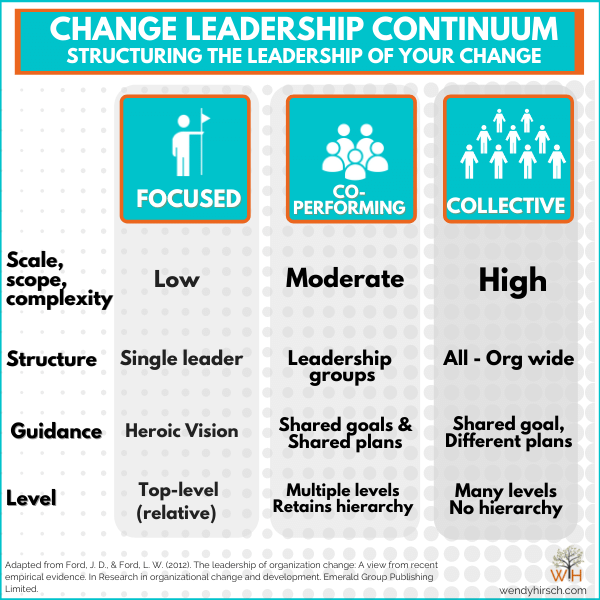Key Points
The leadership structure of an organizational change effort should be tailored to the needs of the change and the context of the organization.
While common, a single-leader model is usually only workable for small changes with low complexity.
As complexity and scale increase so do the leadership demands of change. In such situations, a coalition or collective model may be required to bring the depth of skills, perspectives, and influence required for success.
We often don’t give much thought to who should lead an organizational change. Usually, we simply assume existing structures are a good fit. Spending some time to consider alternatives may be worthwhile, because who leads an organizational change can influence how people experience a change in the organization as well as the outcomes achieved.
The literature on leadership offer three structures to consider: Single Person, Co-Performing Group, and Collective.
Single Person
In the single leader model, which is by far the most common, the individual usually occupies a higher relative place in the organizational hierarchy than those being “led.” In this role, we often envision a hero figure with a vision who leads the organization out of the darkness. Maybe not literally, but our unchecked assumptions about change leadership often align pretty well to that archetype.
It’s true, a single person can lead a change if the scope, scale, and complexity are relatively low. However, as those factors increase, it’s unlikely one person can adequately provide all the leadership required. While there may still be a single person in a change sponsorship role, it’s essential to realize when the diverse skills and perspectives of a leadership group are required to lead the change.
Co-Performing Coalition
Many organizational changes demand diverse leadership skills, perspectives, and bandwidth that can only be provided by a group. This group may be pre-existing, such as a management team, or a group developed explicitly for the change effort. This group may be mandated to provide high-level governance for the change, making decisions on critical aspects of its purpose, budget, and scope. This group, or its members, may also play a role in championing the effort across the organization.
When we view change leadership as a group effort, it can enable the organization and the change sponsor to leverage leaders with unique strengths or perspectives, drawing on multiple functions and even levels of the organization. A co-performing structure also taps into the unique networks —and power and influence — of many individuals. This is significant, as some research has indicated that influence via diverse informal networks is linked with success in large-scale changes.
Collective
Finally, there are organizational changes for which collective leadership is the best fit. In this model, a shared goal is established centrally, but the means of achieving it are locally devised and executed in a decentralized way. Thus, leading the change may become part of the remit of existing leaders of teams or even all individuals who are part of the organization. Managing broad participation to ensure it’s meaningful takes a special skill set. This may be one reason why this change leadership model is often more of an aspiration than a reality.
Tailoring your leadership structure to your change challenge
If you’ve been tapped to lead a change, it’s worthwhile to consider what type of leadership the change demands. If it is a technical change, with a clear solution and small scope, the single-person model may be appropriate. However, if it’s a more substantial or complex effort, a coalition of leaders may be required.
In that case, you’ll need to decide if you’ll add this change to the remit of an existing leadership group or create a new group fit for this purpose. For adaptive changes, for which a clear solution is not known and must be devised in creative ways throughout the organization, collective leadership may be the best fit. This form may still leverage formal leadership structures to support the distributed effort, but would also empower and provide autonomy to teams and individuals to lead localized change efforts.
Finally, it’s important to note that each of these structures and change types may require the change leader(s) to emphasize different change competencies to meet the demands of the effort.
In sum, the answer to the question “who is a (best) change leader?” may be different for each organizational change. Understanding what the change and current context demand, will help you to ensure your chosen leadership structure is fit for purpose.
References
Battilana, J., & Casciaro, T. (2013). The network secrets of great change agents. Harvard Business Review, 91(7/8), 62-68.
Ford, J. D., & Ford, L. W. (2012). The leadership of organization change: A view from recent empirical evidence. In Research in organizational change and development. Emerald Group Publishing Limited.


